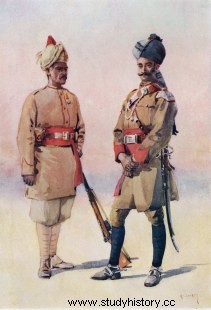
Army of India was the armed force of the British Raj.
Between 1903 and 1947, the Indian Army comprised two distinct entities:
the Indian Army made up of native regiments;
the British Army in India made up of British regiments stationed in India.
First of all to ensure the security of India itself and internal law enforcement missions, the Indian Army also served outside the limits of the territory, in particular during the two world wars. /P>
Origin
After the sepoy revolt in 1858, India was placed under the control of the British crown, becoming the British Raj. Among the many reforms was the reorganization of the army. The Indian Army at that time included Indian units (including the famous Gurkhas) and British units. It was divided into three bodies:
Bengal Army
Madras Army
Bombay Army
She participated in particular in the invasion of Tibet in 1903/1904.
At the beginning of the 20th century, Horatio Herbert Kitchener united these three units and separated the troops into two distinct parts:
the Indian Army with Indian soldiers and British officers
the British Army with troops from the United Kingdom who after about twenty years was renamed British Army in India.
This separation was maintained until the end of the army in 1947. The British and Indian units were commanded by a common structure, with an army divided north and south, composed of 9 infantry divisions and 8 brigades of cavalry.
After Kitchener's amalgamation, the Indian Army had 141,890 infantry, 24,854 (cavalry) and 3,104 (artillery). As for the British Army in India, it had 77,075 men in infantry, 6,065 men (cavalry) and 17,140 men (artillery).
The majority of light armament is produced locally by the Indian Ordnance Factories.
First World War
During the First World War 1914-1918 England entrusted its Indian army commanded by Horatio Herbert Kitchener the landing in France to fight alongside their allies, particularly in Flanders in 1915. The troops landed in Marseille from September 26, 1914 They were first sent by train to Orléans (via Toulouse) on September 30 to receive military training for a few weeks at the Cercottes camp. It was at the end of October that they were sent to the northern front, to a sector stretching from Fauquissat to Givenchy-lès-La-Bassée.
It was divided into several forces:
Force A was incorporated into the British Expeditionary Force. Force A was the troops coming from India integrated into the C.E.B, they arrived on September 30, 1914 in Marseille. It was formed of four divisions which were grouped into an Indian Army Corps, two infantry divisions and a two-division Indian Cavalry Corps. They were commanded by James Willcocks. Lahore's corps was in the lead at the Battle of La Bassée. Force A was disbanded and its infantry sent to Egypt in October 1915, the loss of officers speaking and being accustomed to the troops was sorely felt, almost as much as the cold. Force A had no regimental artillery, lacked training on modern equipment.
Only the two cavalry divisions remained in France, served in support of English troops and also served dismounted. They were withdrawn in March 1918 to also go to Egypt.
More than 130,000 Indians served in France and Belgium, more than 9,000 died there.
World War II
The armed forces fighting in East Asia were placed under the command of the South East Asia Command while many units participated in the Desert War in North Africa, operations in the Middle East including the Anglo-Soviet invasion of Iran and the Italian campaign.
Many Indian prisoners of war were recruited in Europe by the Germans in the SS Freies Indian Legion, by the Italians in the Battaglione Azad Hindustan or by the Japanese with the Indian National Army to fight alongside them under the aegis of the independence leaders. like Subhash Chandra Bose. At the end of the war, cases were brought between November 1945 and May 1946 at the Red Fort in Delhi by the British for waging war against the King-Emperor against the captured officers of the Indian National Army. The trial provoked the anger of the population and a revolt of the Indian army, particularly the Navy, which probably accelerated the process of independence of the country.
During the partition of India, the army was divided into two new national armies:the Indian army and the Pakistani army.
